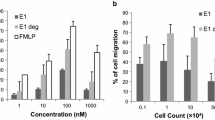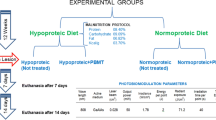Aging is associated with reduction of protein synthesis in cells, which leads to deceleration of proliferative processes in various tissues. Recovery of damaged skin sites was stimulated with a peptide bioregulator chondrolux. This agent is based on an extract from calf cartilage and bone tissue. Its effect on healing of excision wounds was studied in old rabbits. Morphological analysis of the wound surface during various periods of healing was carried out by electron microscopy. The results indicate that chondrolux application to the wound surface stimulated and optimized the reparative process. Active development of granulation tissue was observed as early as on day 14 after wound infliction (vs. days 21-28 in control animals). Acceleration of wound healing was paralleled by an increase in functional activities of fibroblast organelles.
Similar content being viewed by others
References
I. N. Kurilov and G. A. Ryzhak, Byull. Eksp. Biol. Med., 143, No. 6, 682-685 (2007).
V. V. Povoroznyuk, V. Kh. Khavinson, A. V. Makogonchuk, et al., Uspekhi Gerontol., 20, No. 2, 134-137 (2007).
G. K. Popov, I. N. Kurilov, S. V. Bordunovskii, et al., Vestn. Ural’sk. Med. Akad. Nauki, No. 1, 71-77 (2006).
N. I. Chalisova, I. V. Knyaz’kin, and I. M. Kvetnoi, Neuroimmunoendocrine Mechanisms of Peptide and Amino Acid Effects in Tissue Cultures [in Russian], St. Petersburg (2005).
G. S. Ashcroft, M. A. Horan, and M. W. Ferguson, J. Anat., 190, Pt. 3, 351-365 (1997).
R. A. F. Clark, Molecular and Cellular Biology of Wound Repair, Ed. R. A. F. Clark, 341, No. 10, 738-779 (1990).
K. C. Flanders and J. K. Burmester, Clin. Med. Res., 1, No. 1, 13-20 (2003).
J. A. Goliger, Mol. Biol. Cell, 6, No. 11, 1491-1501 (1995).
A. J. McLean and D. G. Le Couteur, Pharmacol. Rev., 56, No. 2, 163-184 (2004).
A. J. Singer and R. A. Clark, N. Engl. J. Med., 341, No. 10, 738-746 (1999).
M. E. Swift, H. K. Kleinman, and L. A. DiPietro, Lab. Invest., 79, No. 12, 1479-1487 (1999).
S. Werner and R. Grose, Physiol. Rev., 83, No. 3, 835-906 (2003).
L. M. Wise, N. Ueda, N. H. Dryden, et al., J. Biol. Chem., 278, No. 39, 38,004-38,014 (2003).
Author information
Authors and Affiliations
Corresponding author
Additional information
Translated from Byulleten’ Eksperimental’noi Biologii i Meditsiny, Vol. 148, No. 12, pp. 678-682, December, 2009
Rights and permissions
About this article
Cite this article
Kurilov, I.N., Ryzhak, G.A. Effect of Peptide Bioregulator on Healing of Excision Wounds in Old Animals. Bull Exp Biol Med 148, 915–919 (2009). https://doi.org/10.1007/s10517-010-0851-1
Received:
Published:
Issue Date:
DOI: https://doi.org/10.1007/s10517-010-0851-1




